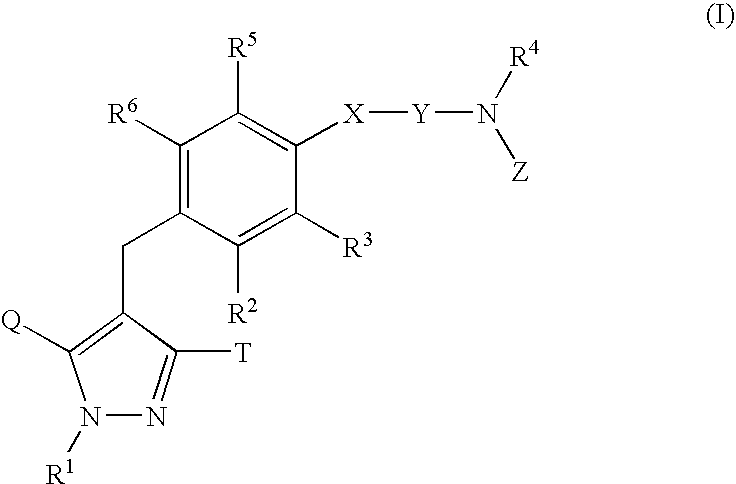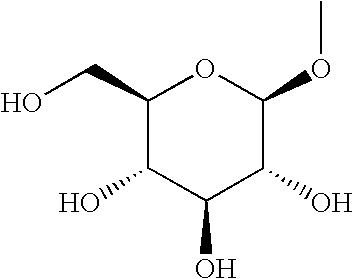Pyrazole derivatives, medicinal composition containing the same, medicinal use thereof, and intermediate for production thereof
a technology of pyrazole and derivatives, applied in the field of pyrazole derivatives, can solve the problems of impaired glucose tolerance, control and continuous performance, etc., and achieve the effect of excellent inhibitory activity of blood glucose level increas
- Summary
- Abstract
- Description
- Claims
- Application Information
AI Technical Summary
Benefits of technology
Problems solved by technology
Method used
Image
Examples
reference example 1
2-Amino-2-methylpropionamide
[0203] To a solution of 2-benzyloxycarbonylamino-2-methylpropionic acid (1 g) in N,N-dimethylformamide (10 mL) were added 251-hydroxybenzotriazole (0.63 g), 1-ethyl-3-(3-dimethylaminopropyl)carbodiimide hydrochloride (1.21 g), triethylamine (1.76 mL) and 28% aqueous ammonia solution (2 mL), and the mixture was stirred at room temperature overnight. The reaction mixture was poured into water, and the resulting mixture was extracted with ethyl acetate. The organic layer was washed with 0.5 mol / L hydrochloric acid, water, 1 mol / L aqueous sodium hydroxide solution, water and brine successively, and dried over anhydrous sodium sulfate. The solvent was removed under reduced pressure to give 2-benzyloxycarbonylamino-2-methylpropionamide (0.26 g). This material was dissolved in methanol (5 mL). To the solution was added 10% palladium-carbon powder (30 mg), and the mixture was stirred at room temperature under a hydrogen atmosphere for 3 hours. The insoluble mate...
reference example 2
2-(2-Nitrobenzenesulfonylamino)acetoamide
[0205] To a suspension of glycinamide hydrochloride (0.11 g) and triethylamine (0.35 mL) in dichloromethane (3 mL) was added 2-nitrobenzenesulfonyl chloride (0.27 g), and the mixture was stirred at room temperature for 1 hour. The reaction mixture was poured into 0.5 mol / L hydrochloric acid, and the resulting mixture was extracted with ethyl acetate. The organic layer was washed with water and brine successively, and dried over anhydrous sodium sulfate. The solvent was removed under reduced pressure, and the residue was purified by column chromatography on silica gel (eluent: dichloromethane / methanol=20 / 1) to give the title compound (72 mg).
[0206] H-NMR (DMSO-d6) δ ppm: 3.57 (2H, d, J=5.9 Hz), 7.1 (1H, brs), 7.33 (1H, brs), 7.8-7.9 (2H, m), 7.95-8.1 (2H, m), 8.16 (1H, t, J=5.9 Hz)
reference example 3
(S)-2-(2-Nitrobenzenesulfonylamino)propionamide
[0207] The title compound was prepared in a similar manner to that described in Reference Example 2 using L-alanine amide hydrochloride instead of glycinamide hydrochloride.
[0208]1H-NMR (CD3OD) δ ppm: 1.33 (3H, d, J=7.1 Hz), 4.03 (1H, q, J=7.1 Hz), 7.75-7.85 (2H, m), 7.85-7.9 (1H, m), 8.05-8.15 (1H, m)
PUM
| Property | Measurement | Unit |
|---|---|---|
| temperature | aaaaa | aaaaa |
| temperature | aaaaa | aaaaa |
| temperature | aaaaa | aaaaa |
Abstract
Description
Claims
Application Information
 Login to View More
Login to View More - R&D
- Intellectual Property
- Life Sciences
- Materials
- Tech Scout
- Unparalleled Data Quality
- Higher Quality Content
- 60% Fewer Hallucinations
Browse by: Latest US Patents, China's latest patents, Technical Efficacy Thesaurus, Application Domain, Technology Topic, Popular Technical Reports.
© 2025 PatSnap. All rights reserved.Legal|Privacy policy|Modern Slavery Act Transparency Statement|Sitemap|About US| Contact US: help@patsnap.com



